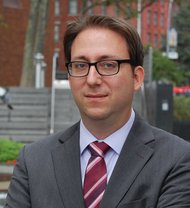 Udi Ofer, photo by Alberto MoralesThe New York Times "SchoolBook" section – "News, data and conversation about schools in New York City" – has an opinion piece about the need for schools to report carefully on who they suspend for what and how frequently. The author, Udi Ofer, writes, "Figures released last week by the City Department of Education show that city schools suspended 5-year-olds at least 35 times and 6-year-olds at least 107 times in the last year alone. That is 142 students who are not old enough to pick out their own clothes but were deemed a big enough threat that they needed to be suspended."
Udi Ofer, photo by Alberto MoralesThe New York Times "SchoolBook" section – "News, data and conversation about schools in New York City" – has an opinion piece about the need for schools to report carefully on who they suspend for what and how frequently. The author, Udi Ofer, writes, "Figures released last week by the City Department of Education show that city schools suspended 5-year-olds at least 35 times and 6-year-olds at least 107 times in the last year alone. That is 142 students who are not old enough to pick out their own clothes but were deemed a big enough threat that they needed to be suspended."
He goes on to suggest that suspending students may not be a cut-and-dried process implemented fairly, and finally suggests alternative means of discipline, including restorative justice:
When most people hear a child was suspended, they assume there was a severe disciplinary problem — that the suspended student is just a “bad kid.”
But a large portion of suspensions are for infractions like insubordination and horseplay, raising concerns that children are being subjected to exclusionary punishments for subjective and minor violations. In Susan Wagner High School on Staten Island, for example, 61 percent of “principal’s suspensions” (five days or less) were for insubordination or horseplay. Similarly, 65 percent of principal’s suspensions in the Academy for Scholarship and Entrepreneurship in the Bronx were for those two infractions.
There is no credible evidence that suspension is an effective method to correct student misbehavior — but we do know that students who are suspended once are more likely to be suspended again and to be involved in the legal system.
In contrast, alternative programs like mediation, counseling, conflict resolution and restorative justice offer real-world examples of dealing with minor infractions in a positive, effective way.
via Reporting on Student Suspensions Is the First Step – SchoolBook.
